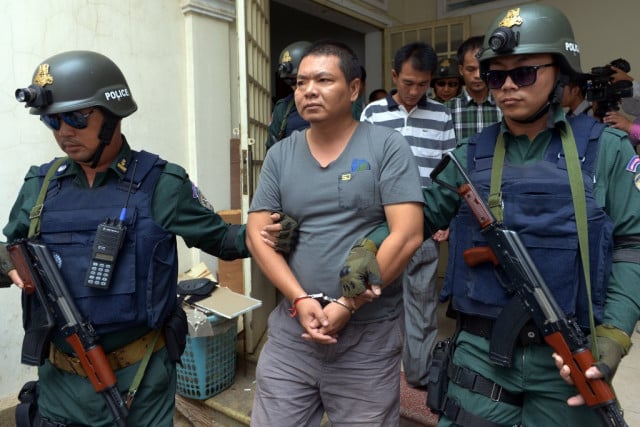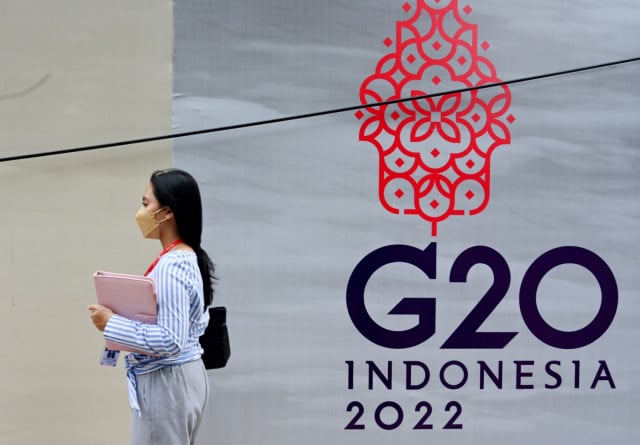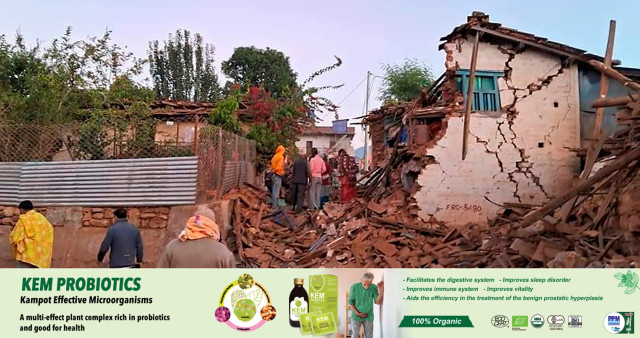Justice: the First Casualty in Cambodia’s War on Drugs

- Gerald Flynn
- June 3, 2020 3:35 AM
The second story of a three-part series on Cambodia’s prisons dives into how a national anti-drugs campaign criminalized a growing public health issue and inadvertently created a crisis for Cambodia’s judiciary and penitentiary systems.
PHNOM PENH--As we hurtle towards the 49th anniversary of former US President Richard Nixon’s infamous declaration of war on drugs, the ramifications of Nixon’s actions—as well as those who followed him—are still being felt acutely here in Southeast Asia. Much has changed since Nixon’s June 18, 1971 address, but the essential futility of criminalizing drug use has not. Through numerous iterations and mutations, Nixon’s war on drugs would not only outlive him, but would go on to expand in scope and scale far beyond the American streets that he had envisaged as the battlefield it would be fought on.
In June 2011, 17 years after Nixon’s death and 37 years since his resignation, the Global Commission on Drugs Policy branded the war on drugs a failure with a report that stated “Vast expenditures on criminalization and repressive measures directed at producers, traffickers and consumers of illegal drugs have clearly failed to effectively curtail supply or consumption.”
Following his declaration of war, Nixon aggressively expanded the powers of federal drug control agencies in the US, but it was future presidents who would carry the torch—leading to the number of people imprisoned in the US for nonviolent drug law offenses to jump from 50,000 in 1980 to over 400,000 by 1997.
“Government expenditures on futile supply reduction strategies and incarceration displace more cost-effective and evidence-based investments in demand and harm reduction,” the report read, calling for an end to the criminalization of people who use drugs and introducing legal reforms instead to undermine organized criminal enterprises as well as to start treating substance abuse as a public health issue.
Despite this groundbreaking 2011 report—and the subsequent annual publications from the commission—Southeast Asian governments embarked on punitive crusades of their own throughout the 2000s, but these invariably generated similar results to those seen in Nixon’s America.
The bloody wake of Filipino President Rodrigo Duterte’s anti-drugs campaign may have captured headlines with his characteristically machismo encouragement of extra-judicial executions, but the impact of Cambodia’s drug war garnered far less attention. There is a vast discrepancy between the Philippines’ official death toll as reported by the police and the number of suspected drug users murdered by vigilantes between July 1, 2016 and June 30, 2019.
In three years, Filipino police reported 5,526 deaths as suspects who “resisted with violence,” but the vigilante killings endorsed by Duterte are thought to be closer to 27,000—often killed unofficially by masked police officers.
It was on Dec. 13, 2016, when Duterte—not yet six months into his presidency of the Philippines—paid a two-day visit to Cambodia, where his meetings with both Hun Sen and King Norodom Sihamoni resulted in a shared vision of tackling the Southeast Asian drugs problem head on. Hun Sen’s refusal to venture as far as Duterte—in terms of extrajudicial killing—did not prevent Cambodia from waging a war on drugs that would lead to rampant overcrowding in prisons and the myriad human rights abuses that followed.
Drug Offenders the Majority
In their May 2020 report on Cambodia’s prison system, Amnesty International examined the root causes of Cambodia’s desperately overcrowded prisons, where 56.9 percent of inmates were imprisoned on drugs charges as of April 2020—in the case of the 2,600 female inmates in Cambodia, 73 percent are imprisoned on drugs charges.
The Ministry of Interior’s spokesman for the Department of Prisons Nouth Savna agreed that drugs charges make up the majority of Cambodia’s prison population, citing the Ministry of Justice’s sluggishness in processing the paperwork as a reason for such a high rate of drugs-related incarceration.
“Around 60 percent of Cambodia’s inmates are detained on drugs charges, drug users also make up the majority of Cambodia’s 17 percent recidivism rate,” Savna said. He added that, on average, there are between 100 to 120 deaths in prisons nationwide, most of them heavy drug users or people who had developed underlying conditions as a result of substance abuse.
Savna noted that, of the approximately 24,000 Cambodians behind bars for drugs offences, less than 1 percent are thought to be heavy drug users. “It’s mostly possession or trafficking, often those who failed rehab—if you fail rehab, you get prison,” he explained.
Savna reiterated the words of newly-appointed Justice Minister Kuet Rith who has established a taskforce to see where the Justice Minister can improve. For Savna, the handling of misdemeanors, alternatives to detention and arranging detainees’ paperwork before they enter the prison system would all be steps in the right direction.
“We don’t have house arrest in our criminal procedures code—I think [former opposition leader] Kem Sokha is the only Cambodian under house arrest. So we do have community-based provisions as an alternative to prison, but there are many conditions to receiving this,” Savna said, explaining that only first-time offenders who have committed a crime that carries less than a 3-year sentence and who have a job and a fixed address are eligible for community-based treatments.
It also must be a crime that is regarded as minor by the community itself, he added, and so the sheer volume of conditions needed to be eligible for this alternative are rarely met.
Possession can see first-time offenders sentenced to two to five years, with repeat offenders facing up to 10 years. The Amnesty International report notes that 39 percent of the 21,740 people jailed on drugs charges between 2017 and 2019 were imprisoned due to minor, non-trafficking offences, including use, possession, administration and facilitation of the use of drugs, with a large majority being arrested with very small quantities of drugs.
No Victory in Southeast Asia’s War on Drugs
The venerable peer-reviewed medical journal The Lancet published a public health and international drug policy paper in March 2016 that was nothing short of an incisive denunciation of hardline drugs policies worldwide.
“One of the greatest impacts of pursuit of drug prohibition identified by the Commission with respect to infectious disease is the excessive use of incarceration as a drug-control measure,” the report read. “Many national laws impose lengthy custodial sentences for minor, non-violent drug offences, and people who use drugs are over-represented in prison and pretrial detention.”
The report condemned policymakers for dismissing the extensive evidence of the negative impacts their policies have created. Through a failure to respect public health and human rights, a neglect of legal responsibility on behalf of the state—particularly in relation to the provision of healthcare in prisons—and a refusal to admit that drugs wars are futile failures, the report suggested that governments are wasting resources, destroying lives and pushing people who use drugs further underground into the clutches of violent organized criminals.
The same year that The Lancet published this illuminating report, the Cambodian People’s Party (CPP) commissioned research from Shaviv Strategy & Campaigns, which—according to a story in the Cambodia Daily—informed Hun Sen and the CPP that they had the most to gain electorally by focusing on law and order. Cambodia’s drug war had begun in earnest at this point, with the Daily reporting that some 8,000 arrests had been made between January 2016 and June 2016.
“The anti-drug campaign in Cambodia is a political strategy for the government, and it has been a winning one,” argues Gloria Lai, regional director for Asia at the International Drug Policy Consortium (IDPC) based in Bangkok. “As long as that is the case, there is not likely to be major change, although there could be an agreement to release some people from prison or the detention centers to relieve overcrowding.”
The origins of Southeast Asia’s hardline approach to drugs are largely rooted in colonial and political history, including pressure from the US to join in the same war on drugs launched by Richard Nixon from the 1970s on, she noted. However, Lai said she has seen a greater level of consideration for the decriminalization of drug use in the past five years, the motivation for this lying in the burdensome growth of prison populations.
“Myanmar has gone the furthest by removing criminal penalties for drug use, but this is a limited measure when possession of any quantity is still criminalized and punished severely,” Lai said. “Thailand legalized the medical use of cannabis. There has been some progress in terms of reducing use of the death penalty for drug offences, e.g. Vietnam, Singapore and Malaysia—which now has a moratorium on executions, but not the sentencing of the death penalty.
“Overall, there is little reason to believe that there will be significant changes to the paradigm of drug policies in the region, and while progress can happen, it will be in very small steps,” Lai added.
This sentiment was echoed in a May 14, 2020, webinar entitled Challenging Over-Incarceration in Southeast Asia hosted by IDPC. During the webinar, Raymund Narag from the School of Justice and Public Safety at the Southern Illinois University pointed to the outdated approaches to drugs as a key area for improvement throughout Southeast Asia.
“There is no online webinar-style approach to hearings and the limited capacity to process those arrested for drugs offences has resulted in prolonged pre-trial detention—some people are spending five to 15 years on trial for low level drug offences and the plea-bargaining systems that have been introduced result in innocent people pleading guilty just for a quicker trial,” Narag noted.
He went on to detail the problems this produces: overcrowded prisons, disease and mental health issues for prisoners and guards, as well as making programs designed to introduce education or skills development impossible with very little rehabilitation actually taking place.
The recidivism rates for Southeast Asia typically range from 30 to 40 percent, which Narag says is in part due to the unique prison culture that defines the Asian prison experience.
“It’s a self-perpetuating mechanism, a self-fulfilling prophecy—a never-ending process of incarceration when we should not see drug use as a criminal problem, but rather a public health issue,” Narag said.
On the Well-Beaten Warpath
Despite the mounting evidence of inevitable failure, Cambodia has marched down an unsustainable warpath against drugs and the people who use them. The National Authority for Combating Drugs (NACD) reported in January 2020 that drug-related arrests have actually increased by about 20 percent when compared to 2019’s figures. Meas Vyrith, NACD secretary-general, said Cambodia’s anti-drugs mission has been successful due to public support.
“We have saved lives of the young generation and protected them from drug-use,” he said.
But when questioned of the efficacy of Cambodia’s protracted campaign, Vyrith was quick to shift blame.
“The anti-drug trafficking department is law enforcement agency, our role is to crack down on the offenders and send them to, court. What happens to them in the next procedures are the responsibilities of the courts and the prisons,” he claimed, stressing again that the NACD s only responsible for arresting people who use drugs.
According to Vyrith’s data, the NACD has dealt with more than 4,000 cases related to drugs between January and June 2020, but did not specify how many people had been arrested.
However, Amnesty International’s report cited the government’s own data to show that Cambodia’s anti-drugs campaign has ultimately failed to reduce drug-use and, in the process, led to systematic human rights violations.
“The periodic reports on the anti-drug campaign released by the government’s National Authority for Combating Drugs (NACD) have not shown any notable reduction in the numbers of recorded ‘drug users.’ The NACD states that there were 20,621 ‘drug users’ at the end of 2016, 18,104 at the end of 2017, approximately 20,000 at the end of 2018, and 19,272 in November 2019,” Amnesty International wrote.
The Lancet reported in March 2016 that the pursuit of drug prohibition has generated a parallel economy run by criminal networks, but Cambodia’s war on drugs has also produced a parallel justice system—one that Amnesty International sees as split between the criminal justice system and the arbitrary rehabilitation centers.
Back in 2011, the UN Committee Against Torture made observations that resound just as clearly in Cambodia nine years later. Writing to Cambodian officials, the committee expressed serious concerns over people being rounded up—particularly marginalized, vulnerable groups—and being detained against their will. And this, the committee said, was being done “without any legal basis or judicial warrant.”
The committee also raised the issue of torture, rape, beatings, suicides and murders—allegations that interviews with former prisoners conducted by Amnesty International suggest are endemic in Cambodia’s drug detention centers.
According to Amnesty International’s study, the country’s drug detention centers are in effect lawless and arbitrary forms of imprisonment, with no oversight—let alone the intention of facilitating rehabilitation for anyone unfortunate enough to wind up incarcerated in one. Amnesty found that there were “at least seven” drug detention centers in Cambodia operated by the Ministry of Social Affairs, Veterans and Youth. In 2016 there were roughly 3,400 Cambodians held in such facilities. By 2017, this had increased 256 percent, the facilities housing some 8,200 people.
During an interview, Din Borey, director of the Department of Rehabilitation at the Social Affairs Ministry, confirmed that the ministry operated eight drug detention centers nationwide and added that the population of people being treated has stabilized.
In 2018, Borey said, 8,120 people, including 444 women, were admitted to Cambodia’s drug detention centers. Last year, that number fell marginally to 8,211, including 436 women, he said, adding that two people detained in these centers had died due to “poisoning.”
“I would like to say that these centers are for treatment and rehabilitation—they are not prisons or detention centers,” Borey said. Treatment can last anywhere between three months and two years, he said.
To qualify for release though, the “patients” must undergo an evaluation of a visiting physician, pass a rehabilitation assessment and agree to appear on a monthly basis at a hospital or health center, as well as submit to ongoing monitoring for up to a year.
“They are cared for in our centers: They are victims,” Borey said.
Anarchy Prevails Over Justice
In contrast, Amnesty International’s findings suggest that Cambodia’s drug detention centers operate in a legal vacuum, where no domestic legislation governs their management or operations and international regulations are frequently ignored.
“These centers not only violate international human rights law, they also operate in the absence of oversight and regulation, rendering people detained therein at heightened risk of human rights violations…there is no provision for judicial supervision of compulsory treatment orders, in violation of international human rights standards governing administrative detention,” Amnesty International writes.
The impact of its report is yet to be seen, although the collective dismissal of its findings by numerous government officials coupled with the towering piles of reports that have suggested similar reforms for over a decade would suggest that rapid change is unlikely in Cambodia or indeed the region.
Despite this, Yohan Misero, advocacy officer at Indonesian Act for Justice, speaking at the IDPC’s webinar, offered a glimmer of hope. “This is an excellent time to review drug policies,” he said. “We can see directly what overcrowding can lead to. So this highlights the value of decriminalization, legislation and non-custodial alternatives.
“Right now, the response is anarchy, but in the long-term, we could see a more coordinated approach to addressing the needs of people who use drugs,” he said.
The future may bring change to prisons in Cambodia and countries in the region—changes that ensure people who use drugs are treated humanely and not used as pawns for the political ambitions of policymakers. But the wheels of progress turn slowly.
For tomorrow’s third and final installment of our series on Cambodia’s prison system, we will look at the impact that such a system has on the lives of people who survive it.
In case you missed it, the first story in our series can be found here.
Additional reporting by Phoung Vantha.















